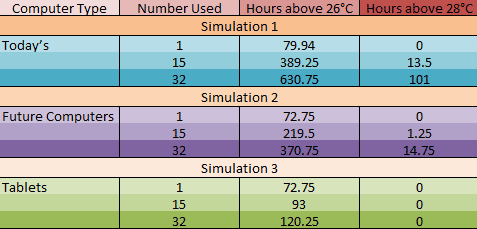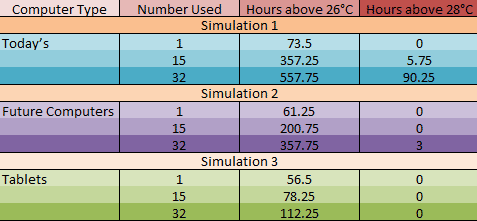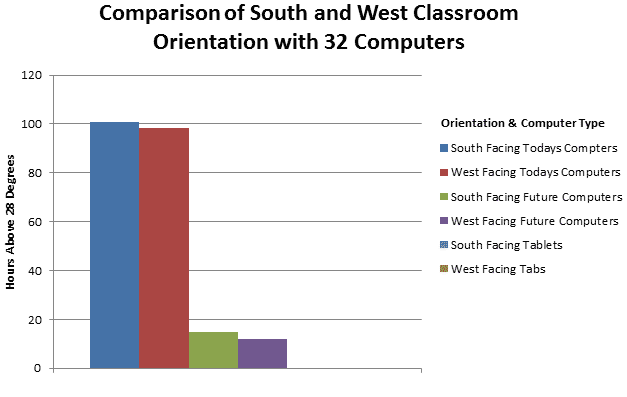
Sensitivity Analysis
Orientation
We have decided to also carry out a sensitivity analysis regarding the orientation of the classroom. By rotating the classrooms to face south, a worst case scenario in terms of overheating could be modelled. As well rotating the model 90°, solar shading was also added to the south facing classroom window to improve the accuracy of the model. Many new buildings today incorporate solar shading on their south façade to minimise solar gains during the summer period, hence significantly reducing the likelihood of overheating. Again, varying numbers of today’s computers, future computers and tablets were simulated in this model to see which, if any, exacerbated the effect of overheating. Table 1.1 below shows the results from the simulations of the south facing classroom.

Table 1: Hours Above 26°C and 28°C For South Facing Classroom
Again, similarly to previous results, it can be seen that as computer power decreases, so does the associated heat. Table 1.2 below shows the previous results for the west facing classroom.

Table 2: Hours Above 26°C and 28°C For West Facing Classroom
It can be seen that on average the south facing classroom has more hours over 26°C and 28°C. It is logical that the south facing classroom would have higher levels of solar gains entering the room. Figure 1.1 below shows the comparison between the south and west orientated classroom with 32 computer types. It shows that the south facing classroom has more hours above 28°C. This is due to higher solar gains from the south, exacerbating the problem of overheating.

Figure 1: Overheating Effects of Orientation
Thirty-two of today’s computers exceed the 80 hour mark above 28°C by 21 hours, meaning overheating has occurred. Again however, with future computers and tablets, hours above 28°C are minimal. Only temperatures for 32 future computers rise above the 28°C mark, only for 3 hours ̶ well below the stated 80 hours of BB101. This simulation verifies that for our classroom, when susceptible to high solar gains facing south, only minimal overheating occurs. Although 28°C is the limit at which overheating ‘officially’ occurs, it should be taken into consideration that 26°C is still warm for an internal environment. It is paramount that children stay focussed and alert; otherwise their education could be negatively affected. Measures should be taken to further reduce internal temperatures during summer overheating periods to limit the number of hours above 26°C that occur, therefore reducing the chances of pupils losing concentration.








